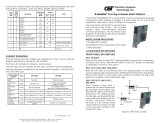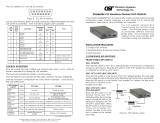Clocking: Network
(default)
Options: Network, Internal, External
Network: This is the most commonly used setting when connect-
ing to a carrier’s network. In this mode, the unit recovers the
clock from the received signal and uses it to transmit data. In
this way the unit remains synchronized to a master clock. In
campus applications, one of the units must be set to Internal
clock, and the other end is set to Network clock. At all times,
there must be only one clock source. Otherwise, clock slips
and framing errors and bit errors may occur.
Internal: This is commonly used in campus applications, where
the unit is not connected to the public telephone network
directly. In this mode, the unit uses the on-board oscillator as
the transmit clock source.
External: This is a special mode that can only be used with the
Unframed format. In this mode, the unit requires a 2.048 Mhz
clock signal from the DTE via the external clock pin on the
DTE interface connector. Most applications will use Network
or Internal clock modes.
CRC-4 Setting: Disabled
(default)
Options: Enabled, Disabled
CRC-4 Multiframe: CRC-4 Multiframe uses TS0 to carry CRC-4
information. It operates independently of CAS MF. When
CRC-4 is enabled, the unit monitors the incoming data stream
for CRC-4 errors. It transmits CRC-4 error counts to the trans-
mitting unit . Excessive errors may cause loss of frame or loss
of sync. If CRC-4 MF is used, both units must be set for CRC-
4 MF; otherwise, the one using CRC-4 MF will detect a loss of
sync.
17
CAS MF Setting: Disabled
(default)
Options: Enabled, Disabled
CAS MF: CAS multiframe uses Timeslot 16 (TS16) to send multi-
frame (MF) alignment data. In CAS MF, a MF is defined as 16
frames, where a frame consists of 32 64kb/s timeslots, num-
bered 0 to 31. TS16 of the first frame in the MF contains the
CAS MF alignment word in the upper four bits. The alignment
word is always 0000 (binary). The 2715 does not perform any
signaling in TS16 other than to insert the MF alignment word,
in order to maintain MF alignment. When CAS MF disabled,
the unit transmits user data in TS16; therefore, up to 31 chan-
nels are available for user data. When it is enabled, TS16 is
not available to the user. In this case, the user can use up to
30 channels for data. CAS MF can be used with CRC-4 MF or
by itself. When enabled, both units must employ CAS MF; if
one unit is set for CAS MF, and the other is not, the one using
CAS MF will detect a loss of sync.
V.54 Loops: Enabled
(default)
Options: Enabled, Disabled
This is a special in-band loopback facility that sends a special pseudo-
random pattern over the data stream. This is the only loopback that the
unit can initiate. This is useful for campus applications when you need
to put a remote unit in loopback. The unit responds to the V.54 loop-
back command, and the whole process takes only a few seconds to
complete. When V.54 Loopback is disabled, the unit will not be able to
send or respond to V.54 loopback commands. The duration of the loop-
back is limited by the loopback timeout setting. While V.54 is being
activated, user data is overwritten.
Default Config Source: Switch (default)
Options: EEPROM, Switch
The Model 2715 can be initialized via the configuration in the on-board
permanent memory (EEPROM) or via the internal DIP switches
(Switch). Once the unit is powered up, you may change the settings
through the control port or the DIP switches. When you make changes
through the control port, no changes will take place or be saved to per-
manent memory until you Save Changes (Main Menu option "d" +
[Enter]). When you make changes through the switches, all changes
are made immediately.
18
d
f
i
j
g























